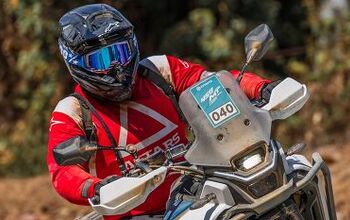MO Tested: Insta360 GO 3 Action Camera Review

The cutest little camera you ever did see
Did you know Motorcycle.com has its own Youtube channel? It’s been around for about a third of MO’s existence, but just in case this is news to you, go check it out. There we have video versions of most of our rides and reviews from the past decade or so. Of course, capturing all that video is no easy task. The hardest part of all is actually getting riding footage from the bike or the rider’s perspective because, unlike a car, there aren’t many spots to actually mount a camera.
This is exactly why the Insta360 GO 3 is quickly assuming a spot front and center in my camera bag alongside my workhorse, the almighty GoPro Hero 11. It would almost replace the GoPro in my bag entirely if it weren’t for one pesky feature, which I’ll explain later. The GO 3’s claim to fame is its tiny form factor and its magnetic backing, allowing it to be mounted in spots we couldn’t mount an action camera before. Here, I’ll get into the features I like, the camera’s flaws, and why it may or may not be a reasonable fit for your camera bag, too.
The Details
Insta360 made a splash in the action camera world because of its 360-degree cameras that allow the user to capture video footage all around them with just one camera and a (relatively) easy app to edit it all with. With GoPro being the 800-lb gorilla in the action camera space, Insta360 found the niche GoPro wasn’t filling and capitalized on it, creating a tug-of-war in the action camera market. With the GO 3, Insta is firmly treading GoPro’s waters.
The GO 3 doesn’t record 360-degree video – it points straight ahead, capturing up to 134 degrees FOV (compared to the GoPro Hero 11 Black’s 122 degrees) with its 1/2.3-inch sensor and 11mm f/2.2 lens. Unlike the Hero 11 Black, the GO 3’s “downfall,” if you want to call it that, is its highest resolution video is 2.7K at 30 frames per second (you’ll have to upgrade to Insta’s new GO 3S for 4K video). To my knowledge, nobody’s ever commented on one of our videos wishing the footage was 4K instead of 2.7K, or even 1080p. Similar to the GoPro, however, is the ability to shoot still photos and time lapse.
As the name suggests, the GO 3 is actually the successor to the GO 2 (though we don’t know anything about a GO 1). The GO2 was a similarly small magnetic action camera, made popular by its tiny form figure you could put almost anywhere. Even though it only shot in 1080p, where the GO 2 failed was with its short recording time, short battery life, and its tendency to run hot. The GO 3 addresses all of those things, and then some.
Read More:
Insta fixed the battery life issue by bulking up the internal battery, but also by attaching the camera (magnetically) to what it calls the Action Pod – essentially a dock that serves as a home base for the camera. The camera itself can record for up to 45 minutes on its own, or up to 170 minutes if it's docked inside the Action Pod. The Pod serves as a secondary battery to power the camera, and when the GO 3 is resting inside it, the whole thing effectively becomes your Go-Pro-style action camera. The box-like resemblance is striking (and probably not coincidental). Attachments included with the box let you use the same GoPro mounts, too. A flip-up touchscreen allows you to change camera settings and frame your shot if you decide to shoot selfies, record yourself vlog style, or if you take the GO 3 out of the Pod.
Shooting With It
Recording with the GO 3 is simple. Power it on and press the record button. That’s it. Hit the record button again to stop the recording. If the GO 3 is out of the POD, pressing the bottom of the camera until it clicks and the LED turns red also does the same thing. Finally, you can use voice commands as well. For my use I prefer pressing the record button, especially since I take the GO 3 out of the Pod a lot. Measuring 1.0 x 2.1 x 0.9-inches without the Pod, this opens up a world of possibilities for getting creative angles that weren’t an option before. For example, after securing some magnets inside my helmet, I could get this creative view:
Opinions are mixed on whether seeing my eyeball while riding is creepy or not (I kinda like it), but having the option is something we didn’t have before. Similarly, if a magnet can stick to it, you can mount the GO 3 there. Even if a magnet doesn’t stick to it, you still have options. I mentioned before the base plate that attaches to the bottom of the Action Pod. It has two posts on the bottom so you can use GoPro mounts – but it, too, is magnetized, so you can mount just the camera to it if space is an issue.
However, my personal favorite accessory is the magnetic pendant included with the GO 3. A strong magnet at the end of an adjustable rope, you can wear it like a necklace under your clothing (or motorcycle gear in this case), place the magnet under the clothing, and stick the GO 3 atop it. Like this:
Advertised as an alternative to the bulky chest-mount, with straps and buckles all over, I found it also effective as a shoulder cam, similar to what they use in MotoGP. Offsetting the camera to a side instead of pointing down the middle offers alternative angles like this:
If you’ve noticed the 16:9 orientation of the screen capture despite the camera being mounted vertically – good eye. With the GO 3, it doesn’t matter which orientation the camera is facing. You can go in the app and choose whether you want a 16:9 orientation, 9:16 orientation, or even a 1:1 orientation.
Another bonus? The camera is waterproof – sorta. Insta360 says the GO 3 is waterproof if you attach the Lens Guard. The Action Pod, however, is not waterproof and is only IPX4 water resistant with the camera placed in it. I put this water resistance to the test when I sampled the Metzeler Roadtec 02 tires at an extremely wet Isle of Man (click the link to watch the video).
It was wet, foggy, and nasty for the whole ride and the GO 3 hung exclusively on the chinbar of my helmet the whole time. At the time, I thought the camera was waterproof and didn’t realize it was just water resistant. Nonetheless, the camera worked flawlessly. Just don’t go swimming with it.
As for the quality of the footage, as mentioned before, I haven’t heard any complaints about the 2.7K quality. The FlowState image stabilization works as advertised, which is obviously important in this line of work. I’ve also had no complaints about the battery life or the heat – both of which I had issues with while using the GO2 previously. Two microphones (instead of the GO2’s single mic) capture better audio, and there’s even a wind reduction feature. However, that’s more suited for wind noise while walking and talking to the camera at the same time. The feature helps pick up the engine note on a motorcycle better, but there’s no escaping the wind noise at the speeds motorcycles travel.
What’s Not To Like?
A few things, actually. There’s a lot to like with the GO 3, but it certainly isn’t perfect. My biggest gripe is the lack of an SD card slot – or any external memory, actually – which is the price we pay for such a small and versatile camera. The GO 3 is available with internal memory of 32GB, 64GB, or 128GB, and footage is uploaded over-the-air via the Insta360 app or by connecting the camera to your computer via a USB-USB-C cable.
Ultimately, I chose to use the cable for a few reasons. First, the Bluetooth connection can be finicky and require several attempts to connect phone to camera in the first place. Second, since I usually upload big files, the peace of mind of the cable connection put me at ease. But, because there’s no external memory, upload speeds are much slower which is annoying.
Then there’s the app itself. While there’s clearly some usefulness in being able to edit footage from your phone, this is best for short clips. Longer stuff is tedious on the app. But what about the AI editor on the app, you say? I didn’t find it to produce anything I felt like sharing whenever I tried to use it. It missed some parts I thought were good and kept other sections I found boring. You’re better off editing from the desktop app or even your third party editor of choice.
My last gripe, and the main reason I still keep a GoPro around, is because you can’t record audio directly to the GO 3. The internal microphone is actually quite good, but it doesn’t compare to having a dedicated mic, especially if you’re trying to ride and talk at the same time. If you’re committed to only carrying one camera, I’ve seen others record audio separately and sync it to the video in post.
Still A Winner In My Eyes
Those negatives surely detract from the GO 3 experience, but ultimately they’re not deal breakers. The compact versatility of the GO 3 far outweigh its shortcomings – and it gives Insta something to shoot for in future iterations of the camera. The GO 3 is available on the Insta360 website in either black or white, and in seven different bundles (including a Motorcycle Bundle) depending on what you plan to use the camera for. Prices range from $399 to $489 however, as of press time, which is just weeks after the GO 3S was released, all colors, all capacities, and all bundles for the GO 3 (non S) are out of stock.
If you don’t need 4K resolution, the standard GO 3 is a great grab. The Motorcycle bundle is seen here with the camera, pendant, base/sticky mount, and a visor/hat mount, which clips onto moto helmets or baseball caps. For street helmets, there’s also a chin mount available separately.
Still, if capturing video on a motorcycle has been something you’ve wanted to dabble in, or if you’re a seasoned veteran in the genre, the GO 3 needs to be a part of your kit. The things you can do with it will really elevate your game.
Become a Motorcycle.com insider. Get the latest motorcycle news first by subscribing to our newsletter here.

Troy's been riding motorcycles and writing about them since 2006, getting his start at Rider Magazine. From there, he moved to Sport Rider Magazine before finally landing at Motorcycle.com in 2011. A lifelong gearhead who didn't fully immerse himself in motorcycles until his teenage years, Troy's interests have always been in technology, performance, and going fast. Naturally, racing was the perfect avenue to combine all three. Troy has been racing nearly as long as he's been riding and has competed at the AMA national level. He's also won multiple club races throughout the country, culminating in a Utah Sport Bike Association championship in 2011. He has been invited as a guest instructor for the Yamaha Champions Riding School, and when he's not out riding, he's either wrenching on bikes or watching MotoGP.
More by Troy Siahaan





































Comments
Join the conversation